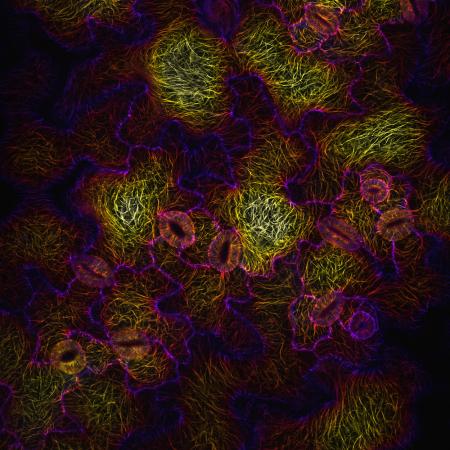For Cells, Internal Stress Leads to Unique Shapes

Credit: Arun Sampathkumar/Caltech
Interested in how these cells individually take on their own unique forms, Caltech biologist Elliot Meyerowitz, postdoctoral scholar Arun Sampathkumar, and colleagues sought to pinpoint the shape-controlling factors in pavement cells, which are puzzle-piece-shaped epithelial cells found on the leaves of flowering plants.
They found that these unusual shapes were the cell's response to mechanical stress on the microtubule cytoskeleton—protein tubes that act as a scaffolding inside the cells. These microtubules guide oriented deposition of cell-wall components, thus providing structural support.
The researchers studied this supportive microtubule arrangement in the tissue of pavement cells from the first leaves—or cotyledons—of a young Arabidopsis thaliana plant (right).
By fluorescently marking the cells' microtubules (yellow, top surface of cell; purple, bottom surface of cell), the researchers could image the cell's structural arrangement—and watch how this arrangement changed over time.
They could also watch the microtubule modifications that occurred due to changes in the mechanical forces experienced by the cells.
Microtubules strengthen a cell's structure by lining up in the direction of stress or pressure experienced by the cell and guiding the deposition of new cell-wall material, providing a supportive scaffold for the cell's shape.
However, Meyerowitz and colleagues found that this internal stress is also influenced by the cell's shape. The result is a feedback loop: the cell's shape influences the microtubule arrangement; this arrangement, in turn, affects the cell's shape, which modulates the microtubules, and so on.
Therefore, the unusual shape of the pavement cell represents a state of balance—an individual cell's tug-of-war to maintain structural integrity while also dynamically responding to the pushes and pulls of mechanical stress.
The results of the study were published in the journal eLife on April 16. Elliot Meyerowitz is George W. Beadle Professor of Biology and an investigator with the Howard Hughes Medical Institute.
Written by Jessica Stoller-Conrad
Contact:
Caltech Media Relations
Media Contact
More Information:
http://www.caltech.eduAll latest news from the category: Life Sciences and Chemistry
Articles and reports from the Life Sciences and chemistry area deal with applied and basic research into modern biology, chemistry and human medicine.
Valuable information can be found on a range of life sciences fields including bacteriology, biochemistry, bionics, bioinformatics, biophysics, biotechnology, genetics, geobotany, human biology, marine biology, microbiology, molecular biology, cellular biology, zoology, bioinorganic chemistry, microchemistry and environmental chemistry.
Newest articles

Bringing bio-inspired robots to life
Nebraska researcher Eric Markvicka gets NSF CAREER Award to pursue manufacture of novel materials for soft robotics and stretchable electronics. Engineers are increasingly eager to develop robots that mimic the…

Bella moths use poison to attract mates
Scientists are closer to finding out how. Pyrrolizidine alkaloids are as bitter and toxic as they are hard to pronounce. They’re produced by several different types of plants and are…

AI tool creates ‘synthetic’ images of cells
…for enhanced microscopy analysis. Observing individual cells through microscopes can reveal a range of important cell biological phenomena that frequently play a role in human diseases, but the process of…





















